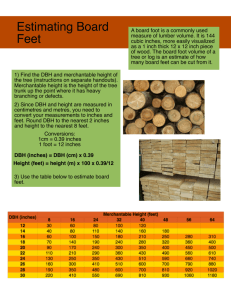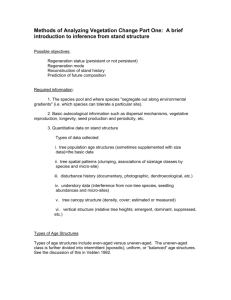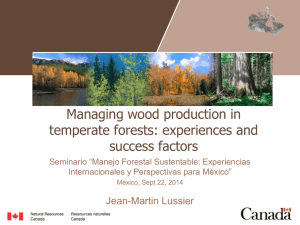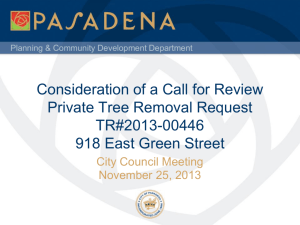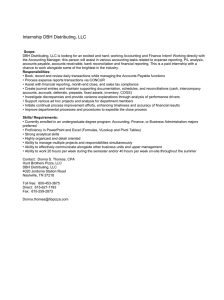Stnding
advertisement
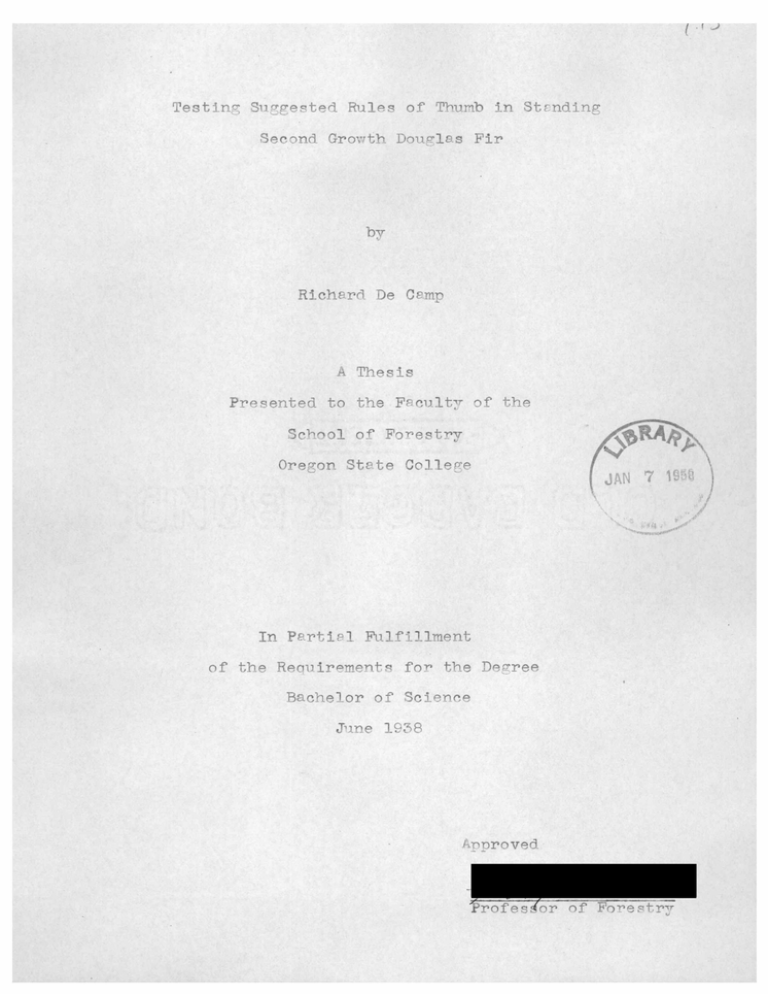
Testing Suggested Rules of Thumb in Stnding Second Growth Douglas Fir by Richerd De Camp A Thesis Presented to the Fscultr of the School of Forestry Oregon State College ( 7 In Partial Fulfillment of the Rprnjirmert for the Deree Bachelor of Sciere June 1938 Irflrov rofesor of Fo'estrr Foreword This psper merely by comprrison the most tteipts to show imnle and accur- ate rule of thumb that can be applied to a stsndlng second growth Douglas Fir tree in order to deteriiine its probable volume in cords. The rules of thumb were submitted by the forest mensuration class to Hrry I. Nettleton, to whom ecknowledgement is made for his kindness in helping with this stiidir. i C ONT ENTS -1 Introduction Purpose of Investigation -1 Importance of Problem -1 Previous Imrestirytions -------------------- 2 Source of Data ------------------------------ 2 Method of Procedure Fieid'fork --------------------------------- 3 Office Computtions ------------------------ 3 over DBH ----------- 4 Àverape Curve of Volu Ech Cord Volune for Chart of Vo1umes DBT-T C1ss ------------- 6 of Eacb Rule of Thumb ----- 7 Perocentae Differ'rces Betveen Rules ------ 9 Results of Comperison Rule Number ----------------------------- 10 i Rule Number 2 ----------------------------- 10 Rule Number 3 ----------------------------- 10 Rule Number 4 ----------------------------- 11 Rule Number ----------------------------- 11 5 Rule Number 6 ----------------------------- 12 Rule Number 7 ---------------------------- 12 Rule Number 8 ----------------------------- 12 Rule Number 9 ----------------------------- Rule Number 10 ---------------------------- 13 Rule Number 11 ---------------------------- 14 ii Conclusion Cause of VF&ristion tn Rules -15 Methods of Stackimr -15 1V!ot Acc,1rte Rule of Thumb ---------------- 15 Reendtion' ---------------------------- 15 i :i Ti. i Tegtin Supested R111es of Thumb Second (rowtb Doucias In Standinz Fir Introcluct ion prim2rr purnose of th.s irvesticrtIon is to dotrriine the most simple and aeeurte rifle of thumb for determining the rrohsbie number of stsckeci cords in a The Douias Fir tree of given DBH anl -rT-it class. The studies for this problem were oui in the Pevr Ahortum, six wi]s north of standing second c"rowth Corvsllis. In oarryinr out thIs study, the necessity for an esy and nrctical 'iesnsof detrmining cordwood volume of stnding trees wss reslized. There re numerous conv.rtn factors to deierriine the number of stsciced cords in different tree snecies of different DBH and height classes, huit in ficoirin the cords, one must aiways have a volume table to first deterine the cubic Mny times a et volume of the tree. foot or bonn person uiy come upon a tree tbt he is desirous of knowing the stacked cord volinuue, hut 1-e has no volume table, so all he can (10 is to estimate the approximate volume. How much simnier it would he if he had a fairly accurte riu]e-of-thumb the he could annl to the DBH and height measurements of the tree. The strcked cord unit is used quite extensively in second rowth Doiu.las Fir for fuel wood estimates on a Friven oren, nnd niso in pnyment for woods operations. Previous InvestiFations To mv knowledce ro studies have been line. A number of studies bve been mde mde along this to determine the amount of solid wood in a cord: the fBctors affecting the eiihlc foot volume of a cord; and to determine the correct ronverting factor to he used when changing cubic foot and foerd foot to cords. However most of tjnese investi'tions have been cerned on in hardwood stands, and in softwood stands used for puinwood. The rules of thumb that were tested were developed by the students in forest mensuration. hundred rules were submitted end. Approximately one from these, eleven were selected that checked out fairly close to a second growth Douglas Fir local cubic foot volume table. height was taken to an eight inch top, which limit used in cord wood cutting. A merchantable is the top 3 Method of P'occ1ure Field Jork The field work on this inve.tiortion reriuired coniderble oniy dRy t1'it Aboreturn. The trees were being eut into cordwood invetition rnnired merchantble heipht eiht to an trees that were felled. on with s nd be taken on all Diameter mesurements were taken diameter tape, standard trpe. the the t thEt the DFH inch to Diameter mesurernents were ll trees thBt were felled. tt'ken Sturdy wre time, for the reason that After the tree beht mesurements with a hd been bricked, splït and st'cked into piles, measurements number of cords in the tree. Tere et the taken to Trees that split bsdly upon If the felling or those with extensive decay were not used. trees were not bucked to an eicbt inch top by the wood eutters A totel of twenty five trees, they viere also disregerded. raninf in diameter from thirteen heitht from sevent' to fort:r inches and in to one hundred and thirty two feet Trees mere me'sured and recorded. bove fort:T inches DJ*I were not considered second p'rowth timber. Office Computations The twenty five trees were clssified into twenty foot heiht seventy rn the e'y cl ses, i.e., every tree to ninety feet in height was cl f3ot height class, ninety one to one hundrec tht nured s from ified into every tree that measured from ten feet in height fled into the one hundred foot class, etc. The ws classi- íretest 5 number of trees fell into the 120 foot height class. rta The then rlced plotting cord volume over DBH, heiht clss. on ordinary graph paper, by a sepsrate curve for each The niotted noints for each height were then connected with straight line end e clnss smooth curve drawn as .the averae ciirve.(Fig. i) After curves had been drawn for each height class, it was made clear that there was only enough samples for the one hundredand twenty foot heiht class everage curve that conid he used. to draw e good None of the other height classes conteined enough samples to draw in an average curve. It weg not nosrible to cet any more samples, so it was essiimed that the rules could he checked by the one hundred and twentir foot heioht c1ss the Had there been nore sanir1es evailehle, riore height classes ooiild have been used and elso the cord volume could have been placed in nroper rntio to both ables by harroni7n th th' indeìndent vari- cljrves. A table(Fig.2) was thBn constructed. by reeord5ng the cord volumes from tue curve for each to DH class from twelve forty inches. A second table(Fig.3) was constructed which ave the cord volume of each rule of thumb for each DBH class. Vol'irrie were tab"ieted for eech DBH cless at four inch intervals from twelve inches to forty inches. The volumes were then totelled for each rule of thurTh, end aleo for the corresponding DBH classes in (Fig.2). T)BH CORDS DBfJ C ORDS 12 .49 27 2.25 13 55 28 2.40 14 .65 29 2.62 15 .75 16 .85 30 31 2.85 3.05 i? .95 .32 3.25 18 1.05 3 3.50 19 1.15 34 3.75 20 1.25 35 4.00 21 1.35 36 4.25 22 1.50 37 4.50 2.3 L5 38 4.75 24 1.80 39 5.00 25 26 1.95 2,10 _________ 5.25 41 5.50 Fig. 2 ech DBH Cord volume taken from grFlph for c1ss in the 120 ft. height c1as Rule o f ___ ______ __ ., i Timb Nmnb e r; #6 I .31 ;.': ::.ic '.7L T 19.54 l.() 14.40 Fig.3---Showin 2.70 :z.42 /fl/ 1O . volumes for each rule of thumb in several DBH classes, Also totals for all for each rule of thumb. (S.C. DBI-I rens stacked clnsses cords) 4.; A third table (Fi.4) shows the total volume for each rule and the total vahirne for the field measurements. s stacked cord as taken from The difference was then deterri5ned between the total volumes and expressed as increase or decrease of the stacked cords. shows a good. corrarision of all the rules. "HOO1 OF FOREStKV iGON STATE COLLEGE CÜRVALLIS, ORE(iûN a percentsr'e The table Tota Thil? S.C. ic.54 2 Volume R.T.C. D % Diff. 13.20 - 6.34 :32.4% 14.40 - 5.14 2,3% - 7.18 36.7% 13.97 - 5.57 28.5% 15.71 - 3.8:3 19,6% 13.39 - 6.1 10.37 - J.l7 17.84 - 1,70 'I 13.90 2435 - 5.50 18.1. 5.64 28.8% 4.81 0' Fig. 4 --- Showing percentage differences between rules of thumhvolurnes and the stacked cord volumes as computed in Fig. 3. 10 Results of Comparison Rule Number i DBH x No. 16' 1ors oo 103 sve large volumes on small trees End This ri1e small volumes on larger trees. On trees in the 18 inch DBH class it checked out verr close. The volume increased roportionaily to the diameter, ecnlaining the small volumeson the larger The rule could never he opplied to trees in the 120 foot class, unless a variable was introduced to increase the volume on 1arer trees. Rule Number 2 (DBH - 8) H? 1200 where: H = Merchantable heiht to 8" top This rule r'ave low volumes for trees of all DBH classes, The rule could be aplied to 12 and 14 Inch classes if a variable number of .1 was added to the viumes of t±,ees in those classes nd it could he apulied to 15 to 20 inch classes if a variable number of .05 was added to the volumes of trees in those classes. The rule however is imracticable. Rule Number 3 DBH x H' 2200 where: H' Merchantable height to 8" top 11 In this rule the volume increased proportionally with the clïameter. trees and a nve a hith volume for small This rule very low volume for large trees. could he very ss It w1l arlied ir sula.er heigh.t clsses such the sixty to eiht?r foot height clsses. It is impr.ctichJe for t}e 120 foot height clns, and seond from the isst of difference from very is in having the greatest percentsge stcked cord volume.(Fi.4) Rule Number 4 _DBH2 H' 2,000 This rule rave small volume for all Hsd this rule used s constant of 4,0fl0 it could very weil he used for trees Height class. trees. 5i7.e instead 52,000 n the 120 foot The volume increases proportionally with thA squsre of the diameter. Rule Number 5 (DBH 1100 where: H Merchantable heiaht to 8" top This rule was similar to rule number 2, difference being, a constant of 1101) the only was used in com- parison to 1200 used in the second rule. The rule gave low volume for trees of all DBH classes. If a constant of 1000 was applied to both rules they would cheek out fine for both rules, two and five. i Rule Number 6 DBH2 x H' 54,000 where; Merel'ìsntahle height to 8' top H This rule Is sinillar to rule number 4, except lt uses a constant of 54,000 where rule number 4 uses a constant of 52,000. Again if the constant of 34,000 in th rule could be used for riled, was tes 120 foot height class. Rule Number - 7 D x .0054 x L 85 where: f) Average dismeter beluen DBH and top DIB of 8" merchantable height to 8" top This rule is very imprncticable, giving very low volumes for ali DBH c1asses(F.4)., It showed the greatest percentage of iifference from the stacked cord volume. The volume being indrect1y nrorortion1 to the average L diameter of the tree, seems to he the rerson. for the slow Increrse in volume for each class. Rule Number R2 85 where: R2 85 radius squared at breast height cubic foot content of the cord This the most wa riiJ.e let anc ccuìte rule The nercent of difference was 8.6 tbat wrg tested. the smn1e of eny rule that WnS tested. (Fir.4) This rule ccild be so used, that it would fit any method of stacking, by either increasing or decrensing the cnnstnt (85) and therefore makin it, variable. If the tree to which this annered rule is to be applied, to be very limby and knotty, the constnt could be decresed to compensate for a decrese in the volume of the stacked cord due to Likewise knots and limbs that prevent closer stacking. if the tree had a clear hole the constant coi1d he in- cred to tckinr'. compenste for closer The sinriteity of the rule makes it ersv to use and easy to remember. Rule Number 9 DBH x No. 16' logs loo .9 This rule proved for srill trees nd iwrcticsbl sr1l v'lumes by giving lrr for lnrre trees. rule niight be anlicable in smaller hei'ht classes, ever, its numerous factors which o to mak t vc']umes This how- up, make it undesireable to use. Rune Nurtherlf) DBH/ x 5L' ) A5 , 000 wep: L merchantable heiatht to 8" top This rule tends away from implicity because of the numerous factors that go to make it up. It a'ives low 14 fnr volumes ali DBH classes, or 85,000 sho1l recroased to about 65,000 to bo b app]Jcable to the 120 foot it probably could snd thArefore the constant heiht class. At the present he used in 80 to 100 foot height classes. Rule Number il ( No. of 2" diameter deviations from 12 to and inciudin.g diameter of tree in question) x (No. of 10' heictht devetetions from 50' hep'ht to snd including height of tree in question) x (.057) This vies ,1 .2 the only rule thet gve a greeter volume than those of stacked cords of corresponding DBH classes (Fig.3) rule . If arplied to 160? to 180' height classes the would prohrbly check appears to be nature. very out very closely. owever, it iriprcticahie beesuse of its lenghty 15 Cínc lus ion rv'n1ete study of all eleven rades it &ppesrs that site wonid very cretly affect the rules of thumb. Different site classes reonire different do different heiht constants n the ru1e -is well classes. These rides were made up for all site 1.ases, to one prticuiBr site, natura1ly their sì-id whefl arnlie wo!lld be a ret variation. Methods of stacking will also inf]xence the accuracy of tbese r'ûes. Or this partIcular site to which these rules were applied, the wood was stacked rather loosely After sorne stacks a ontininn rohb1ir as little sg 75 cubic That no doiht explains the reason for such a great percentage difference between the stacked cords rnd rule feet. of thumb cords. proved to be most accurate 85 and simple rule that cni1d he applied to the 120 foot height class. It is easy to remember and conaista of Rule nunber 8, R ( calculations, the characteristics of a good rule of thumb. The number of cubic feet in a cord or -)pN a few the denominatOr can be chano'ed to meet any method of stackina that may result from the shape or forni o.f the tree in ouestion. This study should he carried out that all heictht classes further, so several ste elaspes are included and are used, In this way a more accurate check could obtained for the rulea. be
